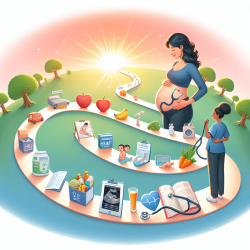Introduction
The ongoing COVID-19 pandemic has prompted a reevaluation of transmission dynamics, particularly among adolescents and young adults (AYA). A recent study, "Reconsidering Assumptions of Adolescent and Young Adult Severe Acute Respiratory Syndrome Coronavirus 2 Transmission Dynamics," highlights the significant role AYA play in the spread of SARS-CoV-2. This blog post will explore the findings of this research and discuss how practitioners, especially those in the field of online therapy, can leverage these insights to improve outcomes for children and adolescents.
Understanding AYA Transmission Dynamics
The study emphasizes that AYA, defined as individuals aged 10 to 24, are a critical demographic in the transmission of SARS-CoV-2. Despite representing approximately 20% of the U.S. population, AYA have not been prioritized in public health responses. The research identifies two key factors contributing to high transmissibility in this group: presymptomatic transmission and asymptomatic case presentations.
Presymptomatic transmission occurs when an infected individual spreads the virus before showing symptoms. The study found that the median serial interval for AYA is significantly shorter than in the general population, indicating a higher likelihood of presymptomatic transmission. Additionally, AYA are more likely to experience asymptomatic or mild symptoms, complicating case identification and isolation efforts.
Implications for Practitioners
Practitioners working with AYA, particularly in educational and therapeutic settings, should consider these transmission dynamics when developing intervention strategies. Here are some practical steps practitioners can take:
- Enhanced Screening: Implement regular and symptom-unspecific testing in schools and therapy settings to identify asymptomatic cases early.
- Education and Communication: Educate AYA about the importance of adhering to public health measures, emphasizing the short-term benefits of compliance, such as protecting family members and maintaining social connections.
- Family Engagement: Involve families in prevention efforts by providing them with specific guidance on minimizing household transmission and supporting AYA in adhering to public health measures.
Encouraging Further Research
While the study provides valuable insights, it also highlights the need for further research to fully understand AYA transmission dynamics. Practitioners are encouraged to engage in or support research efforts that explore the following areas:
- Detailed Age Disaggregation: Conduct studies that disaggregate data by specific age groups within the AYA category to better understand transmission patterns.
- Behavioral Factors: Investigate how AYA's social behaviors and developmental stages influence their role in virus transmission.
- Long-term Effects: Explore the potential long-term impacts of COVID-19 on AYA's physical and mental health.
Conclusion
As we continue to navigate the challenges of the COVID-19 pandemic, understanding the role of AYA in transmission dynamics is crucial. Practitioners can play a vital role in mitigating the spread of the virus by implementing data-driven strategies and encouraging further research. By doing so, we can create safer environments for AYA and improve overall public health outcomes.
To read the original research paper, please follow this link: Reconsidering Assumptions of Adolescent and Young Adult Severe Acute Respiratory Syndrome Coronavirus 2 Transmission Dynamics.










